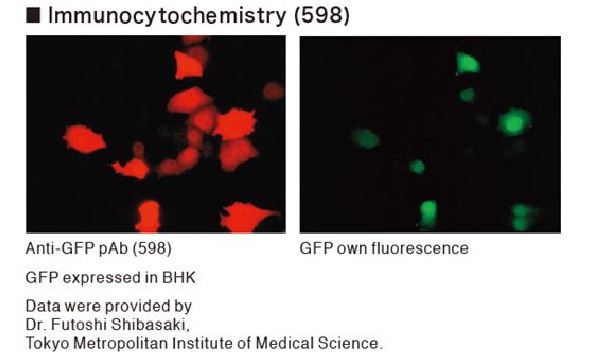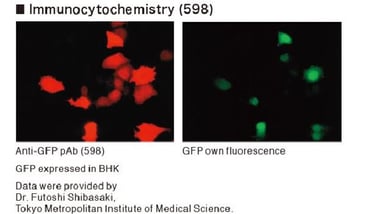Published by Tomohiro Nakajo on

Please Note: MBL International will be shutting down its operations effective December 31, 2024. Distribution of MBL products in the United States will be transferred to Cosmo Bio US on January 1st while European Distributors will remain unchanged. For any US inquiries regarding orders or support during this transition, reach out to Cosmo Bio: https://www.cosmobiousa.com/. For Non-US inquiries reach out to MBL in Japan: https://www.mblbio.com/.
Published by Tomohiro Nakajo on Feb 27, 2018 1:00:00 PM

Green fluorescent protein (GFP) was first isolated by Dr. Osamu Shimomura in 1961. Since then, fluorescent protein (FP) technology has made drastic advancements by many researchers. Currently, FP technology is the most popular tool for visualizing target proteins. Dr. Shimomura, Martin Chalfie and Roger Y. Tsien won the 2008 Nobel Prize in Chemistry to mark their great achievements in life science research.
 MBLI offers the CoralHue® FP series such as Keima-Red, Kusabira-Orange, and many others. We also offer antibodies agaist FPs.
MBLI offers the CoralHue® FP series such as Keima-Red, Kusabira-Orange, and many others. We also offer antibodies agaist FPs.
FP antibodies are used for multiple purposes including pull-down assays, used as epitope-tag, increasing fluorescent intensity if the FP fluorescence is not bright enough, as well as other applications. MBLI offers polyclonal and monoclonal anti-GFP and anti-RFP antibodies with various conjugates including HRP, Agarose, and Magnetic beads. In fact, many researchers prefer to use our bead conjugates for pull-down assays. Our GFP polyclonal antibody (598) is highly regarded to have high performance and reliability among many reseachers. There are over 500 citations to date using this FP antibody.
| Code# | Description | Clone | Applications | Conjugates Available | Notes |
| 598 | Anti-GFP pAb | Polyclonal | WB, IP, IC, IH, ChIP*, Immunoelectron Microscopy | HRP | Cumulative citations over 500 |
| D153-3 | Anti-GFP mAb | RQ2 | IP, IC | Agaraose, Magnetic beads, Magnetic Agarose, Alexa-Fluor | Excellent performance in IP and staining |
| PM005 | Anti-RFP pAb | Polyclonal | WB, IC, IH* | HRP | Highly cited |
| M165-3 | Anti-RFP mAb | 3G5 | IP, FCM, IC | Agarose, Magentic beads, Magentic Agarose | Specialized for IP |
| M204-3 | Anti-RFP mAb | 1G9 | WB | HRP | Specialized for WB |
| M208-3 | Anti-RFP mAb | Cocktail (1G9 and 3G5) | WB, IP, FCM, IC | For multiple applications |
There are many FP variants available today from different resources. Are there the same number of antibodies as FP variants? The answer is no, because FP antibodies have the possibility to cross react to various variants due to high homology among those variants. Our antibodies have been tested for cross reactivity to some variants as shown in the *table below. An open circle shows we have tested our FP antibody with the corresponding variant. N.T. indicates that we have not tested against the variant.
 *Reported in articles
*Reported in articles *Reported in articles
*Reported in articles
Please don’t fret if you don’t see your variant listed! If your FP is not seen in the table above, we can estimate cross reactivity by running a homology search between our antigen and your FP. The following link is a protein BLAST search between our GFP antigen (full length of GFP derived from Aequorea victoria) and your FP. If the homology is high enough, polyclonal antibody (598) has a good possibility that it will cross react with your FP because this antibody has multiple epitopes.
And of course- if you have any questions, please don't hesitate to contact us!